LG SK10Y Review
LG SK10Y
This soundbar supports Dolby Atmos but, sadly, there's no DTS:X
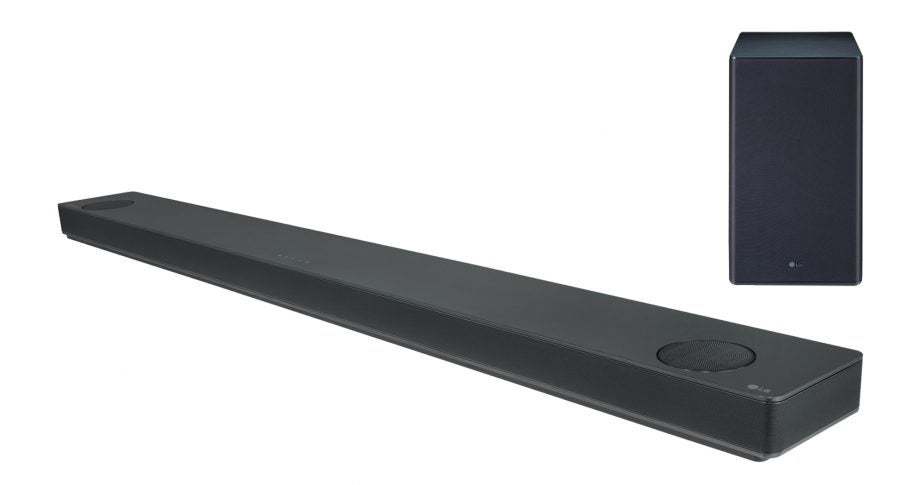
Verdict
This large and well-made soundbar can deliver a big, if rather front-heavy, soundstage from Dolby Atmos and sounds great with music. However, the lack of DTS:X support will disappoint some, and puts it at a disadvantage to the competition.
Pros
- Big soundstage
- Great with Atmos
- Impressive bass
- Attractive design
- Excellent build quality
Cons
- Front-heavy performance
- No support for DTS:X
- More HDMI inputs would be nice
- Audio setup very basic
Key Specifications
- Review Price: £899
- 5.1.2ch system with wireless sub
- Dolby Atmos
- Meridian Technology
- Dimensions: 144.3cm x 6.3cm x 14.6cm
- 550W total power output
- 3 x HDMI, 1 x optical, 1 x analogue
What is the LG SK10Y?
The LG SK10Y is the latest flagship soundbar from the Korean giant, and the first to be developed in partnership with Meridian. It includes support for Dolby Atmos, with LG promising an immersive audio experience thanks to side- and upward-firing drivers built into the soundbar itself.
Thanks to Meridian’s involvement, the SK10Y is designed to sound just as good with music as it does with movies, and to that end it features support for high-resolution audio. The soundbar also promises to work with Google Assistant, and even Chromecast is built in.
Related: Black Friday soundbar deals
LG SK10Y – Design
The SK10Y is a sizeable soundbar that’s clearly intended for use with larger TV screens. It was the perfect fit for my LG 65C8 OLED TV. Despite its size, this soundbar is stylish and sleek: it’s only 6.3cm high. It’s also fairly unobtrusive, with its black brushed metal finish and cloth grille.
You’ll need a generous surface on which to install the SK10Y, and ensure you keep the sideways- and upwards-firing drivers clear of any obstructions. For that reason I wouldn’t recommend putting it in a cabinet – if you could find one large enough, that is. If your stand doesn’t offer enough width, not to worry; there are brackets for wall mounting in the box.
Although I doubt LG actually means for you to use them, there are basic controls on the soundbar itself. These are located at the top, towards the centre of the unit, and allow you to select the input, adjust the volume, set up the Wi-Fi, and turn the power on and off.
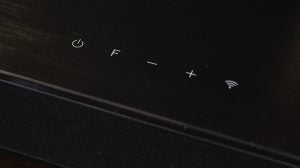
The included remote is the more likely method of control, so it’s a shame it’s rather small and fiddly. At least the buttons are large and sensibly laid out, including power, volume, function (input) and mute. There’s also play/pause and skip controls, along with buttons for info, sound effects, speaker levels, AV sync, auto volume and auto power.
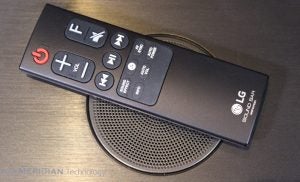
If you’d rather use your TV remote to control the SK10Y then you can, as long as it’s connected via HDMI ARC. You also have the option of using your smart device, thanks to LG’s WiFi Speaker app. This is my preferred choice because you can control the soundbar and view all the options without having to use the eight-character LCD panel on the front of the soundbar.
Related: Best soundbars
LG SK10Y – Features and connectivity
The LG SK10Y is as feature-packed a soundbar as you’re likely to find, with one major exception. The key feature is its ability to decode Dolby Atmos and deliver a 5.1.2-channel surround performance, thanks to forward-, side-, and upward-firing drivers, coupled with a wireless active subwoofer. There’s plenty of power, too, with 7 x 50W in the ‘bar and 200W in the sub, resulting in 550W overall.
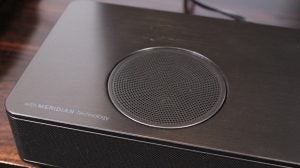
This makes LG’s decision not to include DTS:X simply bizarre. It’s true that Dolby Atmos is the more widespread object-based audio format, but film fans and those interested in immersive audio in general will clearly want their soundbar to support both formats. To compound the problem, the SK10Y doesn’t support lossless DTS-HD Master Audio either.
This strange decision aside, LG has included just about every other feature possible. There’s support for Dolby Atmos, LPCM, Dolby TrueHD, Dolby Digital Plus, Dolby Digital, and DTS Digital Surround. You also get support for Hi-Res Audio up to 24bit/192kHz; MP3, WAV, AAC, AIFF, WMA, OGG, Apple Lossless, and FLAC.
LG is placing a great deal of importance on the SK10Y’s music capabilities, hence the partnership with Meridian. The latter has added its advanced “Bass and Space” and “Height Elevation” technologies, which are designed to create a more immersive listening experience from non-Atmos content.
Related: What is Dolby Atmos? All you need to know
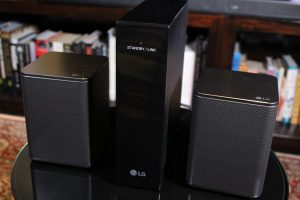
The SK10Y has side-firing drivers designed to create a sense of sound emanating from the rear of the room. However, this approach will never fully replicate that of an actual speaker sitting behind you. For this reason, LG offers the optional SPK8 (£170) wireless rear speaker kit, which adds two rear speakers with 70W of amplification each, resulting in a 7.1.2-channel system and 690W of total power.
The SK10Y wouldn’t be a modern soundbar if it didn’t include a degree of connectivity, and even some voice control. LG has both covered, with Google Chromecast built in, allowing you to cast songs, podcasts and stations from Tidal, Spotify, YouTube and more. It also works with Google Assistant, allowing for voice control when connected to a compatible Google Assistant speaker.
Related: Google Assistant Guide – Features, entertainment, smart home and more
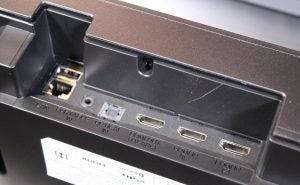
The connections are housed in a recessed area on the underside of the soundbar, and here you’ll find two HDMI inputs (more would be nice), and an HDMI output that supports ARC (Audio Return Channel). All the HDMI connections support Ultra HD 4K/60p, Wide Colour Gamut, High Dynamic Range (HDR10 and Dolby Vision), and HDCP 2.2.
Other connections include an optical digital audio input, a 3.5mm analogue input, an Ethernet port, and a USB port for firmware updates. In addition to physical connections there are also wireless options, with Wi-Fi (2.4/5GHz) and Bluetooth 4.0 built in.
Related: What is HDR? High dynamic range TVs and phones explained
LG SK10Y – Performance
The LG SK10Y is surprisingly easy to set up, and the soundbar and sub should pair automatically on first powering them up. I’d connect any lossless sources directly to the soundbar using the two available HDMI inputs, but all your other sources can be connected to the TV, with their audio sent back to the soundbar using HDMI ARC. If your TV doesn’t support ARC, you’ll need to use the optical connection instead.
The SK10Y can be connected to your home network using either an Ethernet cable or Wi-Fi, which is also easy to set up thanks to the WiFi Speaker app. You can use either the remote or the app to adjust the centre, overhead and subwoofer levels, thus ensuring a balanced sound field. The audio setup is simple, but possibly a bit too simple; it would be nice if LG had added some form of room equalisation on its flagship soundbar.

Once you’ve set up the SK10Y and start using it, there are a number of surround modes you can select. These include Standard, Movie, Music, ASC (Adaptive Sound Control, which optimises the surround effect in real time), and Bass Blast (which boosts the lower frequencies). However, none of these modes are available when the soundbar is decoding Dolby Atmos; they’re reserved for non-object-based audio.
My first impression of the SK10Y was very good – it can deliver a big and open soundstage, which shouldn’t come as a surprise given its size. The front-left and -right channels allow for excellent stereo separation with both music and effects, while the centre channel provides clear and focused dialogue.
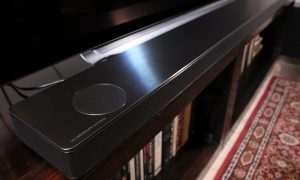
The side-firing drivers add greater width to the front soundstage, but do little to create the sense of surround channels. If you want that, I’d suggest buying the optional rear speakers because that’s the only way to really get sound emanating from behind. LG kindly provided me with a set of rear speakers for this review; they were easy to set up and definitely worked, filling in the acoustical hole behind me.
The upward-firing drivers did a great job of creating the sensation of overhead channels in my lounge, but the success of this effect will depend on your room and the ceiling. In my lounge the ceiling is low, flat, and reflective, which is ideal. If you have a vaulted ceiling then this isn’t the soundbar for you.
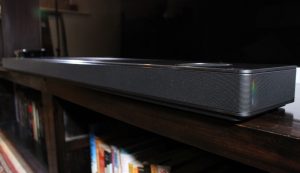
I could send Atmos to the soundbar via ARC when watching shows such as Iron Fist (Netflix) and Jack Ryan (Amazon) on my C8. I could also watch discs with Atmos soundtrack, such as the movie Ready Player One. They all sounded impressive, with a huge wall of sound across the front third of the room. There were effects emanating from the sides and from above, while the superb subwoofer provided a solid low-end platform.
However, I never felt truly immersed by Atmos soundtracks, because there were never any sounds emanating from behind me – either at ear level or from above. Adding the rear speakers helps, but you still don’t get any rear height channels, so the sense of immersion remains limited. The more speakers you have, the more seamless the steering of objects around the room, and the more enveloping the experience.
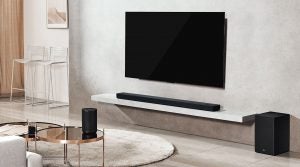
Of course, most of the content you’ll be watching won’t have an Atmos soundtrack – and, thankfully, the SK10Y was very effective with regular 5.1-channel TV shows and movies. The soundstage still felt front-heavy, but this seemed less of an issue with non-Atmos material. There was a pleasing clarity and detail to the soundbar, and the bass was well integrated.
No doubt thanks to the involvement of Meridian, the SK10Y was especially impressive with music. The width of the soundbar itself allowed for plenty of stereo separation, while the imaging and localisation of effects was excellent. The mid-range was nicely rendered, the higher frequencies delivered with skill, and the low-end had a solid presence. Overall, the LG can deliver a balanced and hugely enjoyable experience with music.
Related: Best video streaming services
Why buy LG SK10Y?
The LG SK10Y is an excellent soundbar that combines stylish design and solid build quality, with an impressive performance in both movies and music. The influence of Meridian can be heard in the soundbar’s musicality, while Dolby’s involvement results in a great performance with object-based audio.
The SK10Y can deliver a big wall of sound when decoding Atmos, but the lack of any actual rear speakers means there’s little in the way of genuine immersion. You can add optional surrounds to help fill the hole at the rear, but this will add to the cost. While all “bar and sub” combos struggle to create a truly immersive experience, the lack of DTS:X support is a major disappointment.
This puts the SK10Y at a disadvantage to Samsung’s HW-N850. This soundbar was developed in partnership with Harman Kardon, and also sounds great with music. In addition, it supports high-res audio and works with Alexa, rather than Google. The immersive audio is also very front-heavy, and just like the LG there’s the option to add rear speakers.
The Samsung HW-N850 costs a little more at £999 – but, crucially, it supports both Dolby Atmos and DTS:X, which give it the edge over the SK10Y. The LG certainly does enough to justify its price tag, but whether it’s the right soundbar for you will depend entirely on how much importance you place on DTS:X.
Verdict
This large and well-made soundbar can deliver a big, if rather front-heavy, soundstage from Dolby Atmos and also sounds great with music. However, the lack of DTS:X support will disappoint some, and puts it at a disadvantage to the competition.


